Magnetic nanocomposites for biomedical applications
Nanokompozyty magnetyczne do zastosowań biomedycznych
Mechanik nr 02/2015 - Artykuły z Międzynarodowej Konferencji Innovative Manufacturing Technology IMT 2014 zamieszczone na płycie CD
ABSTRACT: Magnetic carbon nanocomposites (MCNCs), with different constitution and fractions of magnetic component, were fabricated by the pyrolysis of the polymeric precursor. X-ray diffraction, transmission electron microscopy and Raman spectroscopy revealed the presence of nanocrystallites (NCs) of Co, Fe3C and Ni embedded in porous, partially graphitized carbon matrix. Vibrating sample magnetometer measurements enabled to determine the correlation between NCs size distribution and magnetic properties. The magnetic studies confirmed that the coercivity, saturation and remanent magnetizations, as well as fraction of the magnetic component depend on the pyrolysis temperature. The Co#C and Fe3C#C composites exhibited ferromagnetic behaviour with a remanent to saturation magnetization (MR/MS) ratio ranging from 0.25 to 0.3, whereas in the Ni containing samples a relatively small MR/MS ratio points to significant contribution of superparamagnetic interactions.
The Ni#C composites, having superparamagnetic and/or ferromagnetic nanocrystallites in their volume, were chosen to check the ability of heat generation in a magnetic field. It was found that the hysteresis losses were the main mechanism of heat generation. The MCNCs obtained can potentially be applied for hyperthermia treatment.
As the MCNCs are proposed for biomedical application the basic cytotoxicity test were performed to evaluate a potential toxic effect of the materials on MG-63 cells line. The test results confirmed that the composites containing Fe3C are non-cytotoxic whereas the majority of the Ni#C and Co#C composites was characterized as slightly or moderately cytotoxic.
KEYWORDS: magnetic carbon nanocomposite, magnetic properties, pyrolysis, cytotoxicity, biomedicine.
STRESZCZENIE: Magnetyczne nanokompozyty o osnowie węglowej (MCNCs), zawierające różną zawartość i budowę fazową metalicznego komponentu, zostały wytworzone poprzez pirolizę polimerowego prekursora. Dyfrakcja rentgenowska, transmisyjna mikroskopia elektronowa i spektroskopia Ramana wykazały obecność nanokrystalitów (NCs) Co, Fe3C i Ni umiejscowionych w porowatej, częściowo zgrafityzowanej węglowej osnowie. Badania właściwości magnetycznych potwierdziły, że koercja, namagnesowanie nasycenia i remanencja oraz zawartość magnetycznego komponentu zależą od temperatury pirolizy. Kompozyty Co#C i Fe3C#C wykazują właściwości ferromagnetyczne, ze stosunkiem remanencji do namagnesowania nasycenia (MR/MS) w zakresie 0,25 – 0,3, podczas gdy dla kompozytów zawierających Ni stosunek MR/MS wskazuje na znaczący wkład od oddziaływań superparamagnetycznych. Kompozyty Ni#C, zawierające nanokrystality ferromagnetyczne lub superparamagnetyczne zostały wybrane do zbadania zdolności do generowania ciepła w zmiennym polu magnetycznym. Stwierdzono, że straty na histerezę odgrywają decydującą role w generowaniu ciepła. Wytworzone MCNCs mogą zatem być potencjalnie stosowane w hipertermii.
Badania cytotoksyczności, przeprowadzone z zastosowaniem linii komórkowej MG-63 wykazały, że kompozyty zawierające Fe3C są nietoksyczne, natomiast większość kompozytów Ni#B and Co#C można określić jako mało lub umiarkowanie toksyczne.
SŁOWA KLUCZOWE: nanokompozyt magnetyczny, właściwości magnetyczne, piroliza, cytotoksyczność, biomedycyna.
BIBLIOGRAFIA / BIBLIOGRAPHY:
- F. YU, L. ZHANG, Y.Z. HUANG, et al., The magnetophoretic mobility and superparamagnetism of core-shell iron oxide nanoparticles with dual targeting and imaging functionality, Biomaterials 31, 5842–8 (2010).
- S.R. RUDGE, T.L. KURTHZ, C.R. VESSELY, et al., Preparation, characterization, and performance of magnetic iron-carbon composite microparticles for chemotherapy, Biomaterials 21, 1411-20 (2000).
- J. JOHNSON, T. KENT, J. KODA, C. PETERSON, S. RUDGE, G. TAPOLSKY, The MTC technology: a platform technology for the site-specific delivery of pharmaceutical agents, European Cells and Materials 3 (2), 12-5 (2002).
- M. IZYDORZAK, A. SKUMIEL, M. LEONOWICZ, et al., Thermophysical and magnetic properties of carbon beads containing cobalt nanocrystallites, Inter. Journ. of Thermophysics A. 33, 627-39 (2012).
- SKUMIEL, M. IZYDORZAK, M. LEONOWICZ, et al., Thermophysical and magnetic properties of carbon beads containing nickel nanocrystallites, Inter. Journ. of Thermophysics A. 32, 1973-85 (2011).
- J.M. NAM, C.S. THAXTON, C.A. MIRKIN, Nanoparticles-based bio-bar codes for the ultrasensitive detection of proteins, Science 301, 1884–6 (2003).
- F. PATOLSKY, Y. WEIZMANN, E. KATZ, et al., Magnetically amplified DNA assays (MADA): sensing of viral DNA and single-base mismatches by using nucleic acid modified magnetic particles, Angew. Chem. Int. Ed. 42, 2372–6 (2003)
- P. POUPONNEAU, J.Ch. LEROUX, S. MARTEL, Magnetic nanoparticles encapsulated into biodegradable microparticles steered with an upgraded magnetic resonance imaging system for tumour chemoembolization, Biomaterials 30, 6327-32 (2009).
- Z.M. SAIYED, S.D. TELANG, C.N. RAMCHAND, Application of magnetic technique in the field of drug discovery and medicine, BioMagn. Res. Technol. 1(2), 1-8 (2003).
- Ch.S.S.R. KUMAR, F. MOHAMMAD, Magnetic nanomaterials for hyperthermia-based therapy and controlled drug delivery, Adv. Drug Deliv. Rev. 63, 789-808 (2011).
- A.D. POMOGAILO, G.I. DZHARDIMALIEVA, Frontal polymerization of metal-containing monomers: achievements and problems, Polym. Sci. Ser. A 46, 250-63 (2004).
- S. REICH, C. THOMSEN, Raman spectroscopy of graphite, Physical and Engineering Sciences 362, 2271-88 (2004).
- C. BENY-BASSEZ, J.N. ROUZAUD, Characterization of carbonaceous material by correlated electron and optical microscopy and Raman microspectroscopy, Scanning Electron Microscopy 1, 119-32 (1985)
- V. DATSYUK, M. KALYVA, K. PAPAGELIS, Chemical oxidation of multiwalled carbon nanotubes, Carbon 46, 833–40 (2008).
- X.M. SUN, Y.D. LI, Colloidal carbon spheres and their core/shell structures with noble-metal nanoparticles Angew. Chem. Int. Ed. Engl. 43, 597-601 (2004).
- J.J. HOST, J.A. BLOCK, K. PARVIN, et al., Effect of annealing on the structure an magnetic properties of graphite encapsulated nickel and cobalt nanocrystals, J. Appl. Phys. 83, 793-801 (1998)
- C.H.P LUPIS, Chemical Thermodynamics of Materials, North-Holland, New York NY (1983), pp. 66 and 74
- I.M. LIFSHITZ, V.V. SLYOZOV, The kinetics of precipitation from supersaturated solid solutions J. Phys. Chem. Solids 19, 35 (1961).
- D. FAN, L.-Q. CHE, S.P. CHEN, et al., Phase field formulations for modeling the Ostwald ripening In two-phase systems, Computational Materials Science 19, 329-336 (1998).
- B. BOKHONOV, M. KORCHAGIN, The formation of graphite encapsulated metal nanoparticles during mechanical activation and annealing of soot with iron and nickel, J. Alloy Compd. 333, 308-20 (2002).
- M.P. FERNÁNDEZ-GARCÍA, P. GORRIA, M. SEVILLA et al., Enhanced protection of carbon-encapsulated magnetic nickel nanoparticles through a sucrose-based synthetic strategy, J. Phys. Chem. C 115, 5294-300 (2011).
- E.P. SAJITHA, V. PRASAD, S.V. SUBRAMANYAM, S. ETO, K. TAKAI, T. ENOKI, Synthesis and characteristics of iron nanoparticles in a carbon matrix along with the catalytic graphitization of amorphous carbon, Carbon 42, 2815-20 (2004).
- R. FISCHER, H. KRONMULLER, The role of the exchange inter-action in nanocrystalline isotropic Nd2Fe14B-magnets. J. Magn. Magn. Mater. 91, 225–33 (1999).
- D.J. SELLMYER, C.P. LUO, Y. QIANG, et al., Handbook of Thin Film Materials, Vol. 5, Academic Press, San Diego (2002), Chapter 7.
- M. IZYDORZAK, A. SKUMIEL, M. LEONOWICZ, A.D. POMOGAILO, G.I. DZHARDIMALEVA, Thermophysical and magnetic properties of carbon beads containing cobalt nanocrystallites, J. Thermphysics 33 (4) (2012) 637-639.





















